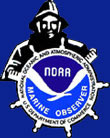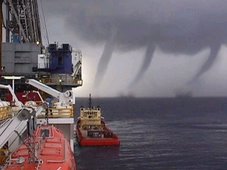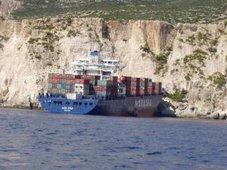 CG funds turbine impact on radar study
CG funds turbine impact on radar studyThe Coast Guard revealed this week that it has contracted for a study of the effects on marine radar from the wind farm proposed for Nantucket Sound.
At the end of a radar and navigation forum Tuesday in North Falmouth, Raymond Perry, captain of the port for Sector Southeastern New England, announced the study, Coast Guard Senior Chief Richard Uronis said yesterday.
The $100,000 study should be completed by December, Uronis said. It will be performed by Maryland-based Technology Service Corp.
A second forum on radar and navigation issues is being planned after the study is complete, he said.
Cape Wind Associates wants to build 130 wind turbines on 25 square miles in the middle of Nantucket Sound. Advocates say it would provide clean energy with minimal impact on the local environment and maritime safety.
Opponents have decried the plan, citing concerns ranging from the impact on endangered birds to navigational and safety issues discussed at Tuesday's forum.
As part of a draft environmental impact statement released in January by U.S. Minerals Management Service — the lead agency reviewing Cape Wind — the Coast Guard placed a list of conditions on its approval of the project. The conditions required the Minerals Management Service and Coast Guard to determine whether "identified impacts, if any, allow for an acceptable risk to navigation safety."
The Minerals Management Service expects to issue a final report on Cape Wind by the end of the year. Agency officials did not return messages yesterday seeking comment on whether the Coast Guard radar study would influence their review of Cape Wind.
At Tuesday's forum, dueling radar analyses were presented to Perry that drew different conclusions on the impact of the proposed wind turbines.
According to Raytheon principal engineering fellow Eli Brookner, there are three potential problems Nantucket Sound wind turbines could pose for radar.
"If you had a small vessel located in what we call the side lobes you wouldn't see it, and so it could be a hazard not seeing that target," Brookner said in a telephone interview yesterday.
Side lobes are radar beams that spill over from the main beam and can cause "clutter," Brookner said.
Additionally, so-called "shadowing" can occur when turbines or ships behind the closest turbines may be obscured on radar screens, he said.
Finally, radar systems that automatically track targets may "swap" a moving target such as a ship with a stationary turbine, Brookner said.
Brookner said he studied maritime radar issues at the request of a friend whom he did not identify and was not paid for his work.
Glenn Wattley, the president and CEO of the region's main anti-Cape Wind group, the Alliance to Protect Nantucket Sound, said his organization asked Brookner to look at the radar issue but did not pay him.
Capt. Dennis Barber, a British ship captain who has worked as a consultant for Cape Wind, presented an opposing view of the impact of the proposed turbines Tuesday, saying that mariners could easily determine the location of nearby boats near the proposed wind farm, according to attendees of the forum. Barber could not be reached for comment yesterday.
About 20 panelists debated other navigational issues Tuesday, including whether there should be a wider buffer zone between the wind turbines and ferry routes, Uronis said.
"We need a proper spacing between the ferry route and the wind towers," Edmund Welch, a spokesman for the Passenger Vessel Association, a trade group that represents the Woods Hole, Martha's Vineyard and Nantucket Steamship Authority and the Hy-Line ferry lines, said in a telephone interview yesterday.
A Cape Wind spokesman did not return a telephone call last night seeking comment.
Researchers are homing in on the hurricane-prone Gulf of Mexico and Caribbean Sea to assess the likely changes, between now and the middle of the century, in the frequency, intensity, and tracks of these powerful storms. Initial results are expected early next year.
The National Center for Atmospheric Research (NCAR) in Boulder, Colo., working with federal agencies as well as the insurance and energy industries, has launched an intensive study to examine how global warming will influence hurricanes in the next few decades.
The goal of the project is to provide information to coastal communities, offshore drilling operations, and other interests that could be affected by changes in hurricanes.
"This science builds on years of previous investment," said Cliff Jacobs, program director in the National Science Foundation (NSF)'s Division of Atmospheric Sciences, which is funding the project. "The outcome of this research will shed light on the relationship between global warming and hurricanes, and will better inform decisions by government and industry."
The project relies on an innovative combination of global climate and regional weather models, run on one of the world's most powerful supercomputers.
"It's clear from the impacts of recent hurricane activity that we urgently need to learn more about how hurricane intensity and behavior may respond to a warming climate," says NCAR scientist Greg Holland, who is leading the project. "The increasingly dense development along our coastlines and our dependence on oil from the Gulf of Mexico leaves our society dangerously vulnerable to hurricanes."
The new study follows two major reports, by the U.S. Climate Change Science Program (CCSP) and Intergovernmental Panel on Climate Change (IPCC), that found evidence for a link between global warming and increased hurricane activity.
But many questions remain about future hurricane activity. For example, the CCSP report concluded that future changes in frequency were uncertain, and that rainfall and intensity were likely to increase, but with unknown consequences.
Improved understanding of climate change and hurricanes is an especially high priority for the energy industry, which has a concentration of drilling platforms, refineries, pipelines and other infrastructure in the region that are vulnerable to severe weather.
Hurricanes Gustav and Ike damaged offshore oil production and several refineries, disrupting gasoline supplies.
The project is part of a larger effort examining regional climate change between 1995 and 2055.
The simulations are being run on NCAR's bluefire supercomputer with support from NSF, NCAR's sponsor, and through a long-term collaboration with the insurance industry through the Willis Research Network.
"This research program by NCAR is a major contribution to the insurance industry and public policy makers," says Rowan Douglas, managing director of Willis.
"The primary way to improve our understanding of present and future hurricane risk is to generate computer simulations of storms in unprecedented detail."
For the project, the model will examine three decades in detail: 1995-2005, 2020-2030, and 2045-2055. Scientists will use statistical techniques to fill in the gaps between these decades.
A major goal is to examine how several decades of greenhouse-gas buildup could affect regional climate and, in turn, influence hurricanes and other critical weather features. Scientists will also investigate the impact of the powerful storms on global climate.
One of the most difficult technical challenges for such a project is to create a model that can capture both the climate of the entire world and the behavior of a single hurricane.
To get around this roadblock, NCAR has developed an approach called Nested Regional Climate Modeling (NRCM). The center "nests" a special version of its high-resolution weather model (the Weather Research and Forecasting model, or WRF) inside its lower-resolution, global climate model (the Community Climate System Model, or CCSM).
The resulting simulations show fine-scale detail for certain regions, like the Gulf of Mexico, while also incorporating global climate patterns.
For each of its decade-long time slices, the NRCM's resolution will be about 20 miles across Africa, Europe, and the South Atlantic, 7.5 miles across the tropical Atlantic and northeastern United States, and an even sharper 2.5 miles over the Caribbean and Gulf of Mexico, southeastern United States, and drought-prone western United States.
"Combining weather and climate models in this way enables more detailed projections of hurricanes in a warming world than any study to date," says Holland. "These projections will help reduce the uncertainty of current assessments, and they also serve the very important role of providing experience about applying future predictions of changes to high impact weather systems in general."-National Science Foundation
MARITIME NOTE
U. S. Coast Guard Rescues Sailors Remotely from 3,500 Miles Away - it's AMVER!

The following Coast Guard story was spotted in Euroweekly News, the English news source in Spain for Mallorca, Costa Blanca, Costa de Almeria, Costa del Sol, Heart of Andalucia and Algarve.
The U. S. Coast Guard's sophisticated AMVER system enabled a daring sea resuce to take place 3,500 miles from the Coast Guard AMVER Center on Governor's Island in New York.
.
Four Swedish sailors were rescued last week by the Greek tanker, ‘Parthenon’, in a dramatic high-seas rescue which was hampered by weather so rough that a rescue helicopter had to return to shore.
Swedish Sailboat, Sun Chaser, in distress
.
The US Coast Guard revealed in a press release that Captain Vasileiadis Lazaros, master of the Greek-flagged tanker, was sailing to the Port of Setubal when his crew picked up a distress call from the Swedish sailboat, ‘Sun Chaser’ which was in difficulties approximately 84 miles west of the Algarve’s Cape Saint Vincent. Within two minutes of receiving the call, Captain Lazaros was on the bridge, directing the ship to proceed to the stricken sailboat.
.
The distress call was received through the ‘Automated Mutual Assistance Vessel Rescue System’ (AMVER), sponsored by the United States Coast Guard, a computer-based, voluntary global ship-reporting system used worldwide by search and rescue authorities to arrange for assistance to persons in distress at sea. The ‘Parthenon’ has been an AMVER participant since 2003.
.
Greek Tanker Races to the Scene
.
Steering the 800 foot tanker, managed by the Tsakos Group of Athens, towards the distress location, Captain Lazaros notified Portuguese rescue authorities. “I ordered all crew to stand-by on deck,” stated Captain Lazaros as he began preparing to rescue the four Swedes. Coordinating his efforts with Radio Lisbon, Captain Lazaros overheard a Portuguese rescue helicopter order the Swedish sailors into a lifeboat.
.
“The sailors radioed the rescue helicopter and said they could not abandon ship in the rough weather because their lifeboat had been ripped from the sailboat and drifted away,” Captain Lazaros added. As the weather conditions deteriorated, the helicopter was unable to safely hoist the sailors and returned to base, leaving the 107,000 ton dead- weight tanker the only means of rescue for the sailors.
.
“I ordered the Sun Chaser to make fast to our port side amidships and had the crew lay down the pilot ladder,” Captain Lazaros recounted in an email to the U. S. Coast Guard AMVER center. Within two minutes of lowering the pilot ladder, the first survivor was safely on board the Parthenon. Within three hours of receiving the initial call for help, the Parthenon had rescued all four Swedish sailors.
.
The Survivors
.
The survivors, two men and two women, were cared for aboard the Parthenon before being taken to Setubal, where they were met by Portuguese officials. With the AMVER system, rescue coordinators can identify participating ships in the area of distress and divert the best-suited ship or ships to respond. Prior to sailing, participating ships send a sail plan to the Amver computer centre. Vessels then report every 48 hours until arriving at their port of call. This data is able to project the position of each ship at any point during its voyage and, in an emergency situation, any rescue coordination centre can request this data to determine the relative position of AMVER ships near the distress location. On any given day, over 3,300 ships are available to carry out search and rescue services.
.
About AMVER:
.
AMVER, sponsored by the United States Coast Guard, is a unique, computer-based, and voluntary global ship reporting system used worldwide by search and rescue authorities to arrange for assistance to persons in distress at sea.With AMVER, rescue coordinators can identify participating ships in the area of distress and divert the best-suited ship or ships to respond.
.
AMVER's mission is to quickly provide search and rescue authorities, on demand, accurate information on the positions and characteristics of vessels near a reported distress.
Weather Eye: noisy oceans threaten life under water
he world’s oceans are growing noisier, thanks to the rising levels of carbon dioxide. This could create a cacophony of sounds that will make life difficult for whales and dolphins, which use their shrills and rumbles for navigation and communication and, rather like a room full of people shouting at each other, their calls could get lost in an underwater din.
It seems unbelievable that carbon dioxide would make a difference to anything on Earth because it only makes up about 0.04 per cent of the atmosphere. But when air dissolves in water, the carbon dioxide makes carbonic acid. Although a very weak acid, it slowly eats away chalk and limestone, which is how Cheddar Gorge and its caves were made.
As carbon dioxide dissolves in the oceans it is turning the water more acidic. This has an impact on sound travelling through the water, because sound waves are absorbed by certain types of charged molecules that stick together in seawater. As the sea becomes acidic, the charged molecules absorb less sound, and so the sound waves travel further.
A recent study has found that carbon dioxide absorbed by the oceans has increased sound travel by about 10 per cent throughout the Atlantic and Pacific. And by mid-century this is expected to rise up to 70 per cent further. With noise travelling further, this could create an underwater din that will make life much more difficult for whales and fish that live on reefs that also use sound.
The increasingly acid oceans are also hurting sea creatures such as diatoms and corals. Their shells are made of carbonate that is corroded by carbonic acid.
Have a great and safe weekend!
RS


































































































![Validate my RSS feed [Valid RSS]](valid-rss.png)